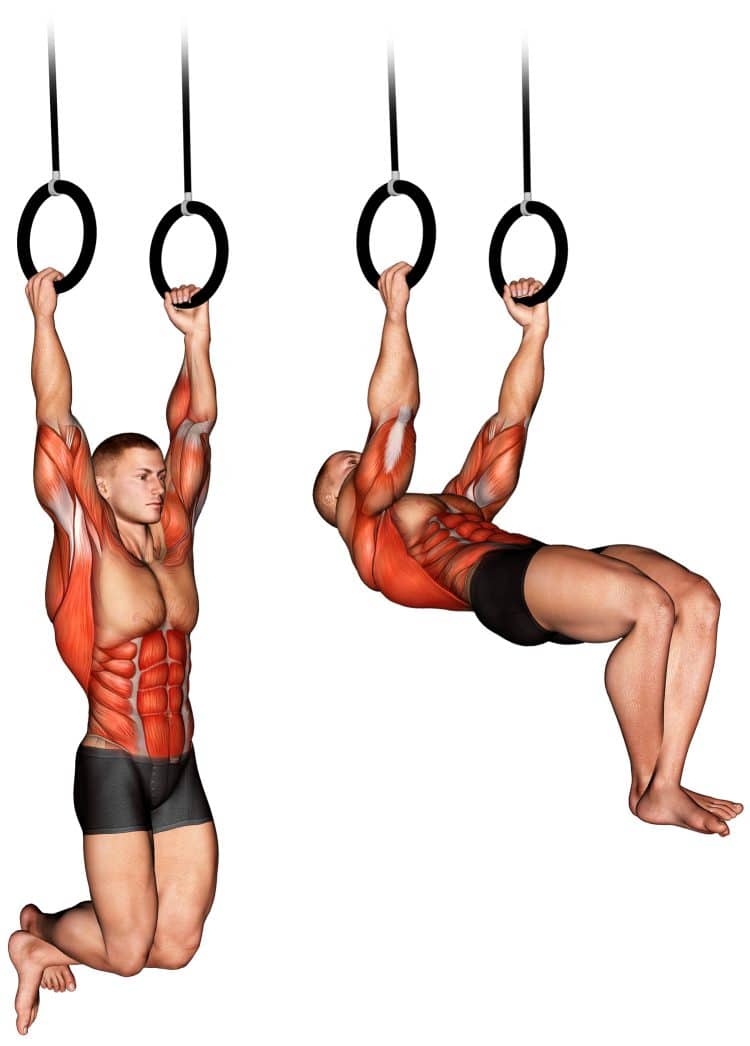Much like the popular CrossFit-based kipping pull-up, the kipping muscle up is a technique used to complete more work (timed workouts) in less time. This multi-movement exercise involves various elements strategically performed to create the momentum to propel you up and over a bar or rings and into a full bodyweight dip.
Below we’ve created a complete kipping muscle ups guide that includes movement instructions, key form tips, benefits, variations, muscles worked, and more.
How To Do The Kipping Muscle Up
The kipping muscle up is not a beginner movement as it requires decent upper body strength, flexibility, coordination, and proper technique. That being said, it may take some practice to get the hang of (pun intended) even for more experienced exercisers.
Choosing A Pull-Up Bar
Kipping muscle ups require a sturdy bar, enough swinging room, and plenty of overhead space to avoid hitting your head on the ceiling. If you’re looking for a good pull-up bar setup, we recommend the follow options.
Below we’ve included detailed step-by-step instructions for the kipping muscle up.
Step 1: Bar Hang
- Start from a dead hang with the hands just outside shoulder width and arms fully extended.
- Pull your shoulder blades down and back. This is important for shoulder health and proper movement of the scapula.
Step 2: Kip Swing
The Kip swing is a CrossFit technique used to create momentum to help propel the body up and over the bar. The motion is initiated using the shoulders and hips to alternate between hollow and arched body positions.
Level Up Your Fitness: Join our 💪 strong community in Fitness Volt Newsletter. Get daily inspiration, expert-backed workouts, nutrition tips, the latest in strength sports, and the support you need to reach your goals. Subscribe for free!
Creating momentum
This portion of the movement is crucial because you have to generate enough momentum using proper body mechanics to get yourself completely up and above the bar.
To do it:
- Keeping your arms fully extended, swing yourself back by pushing against the bar while simultaneously swinging the legs forward and pulling the knees up toward your chest.
- Now swing your hips forward by pulling the arms behind the head and simultaneously swing the legs back.
Practice swinging back and forth between hollow and arched body positions to get comfortable with the movement.
Step 3: Pullup transition to a dip
Now that you’ve got the swing down pat, it’s time for the pullup phase. Before you can effectively launch up and over the bar, there a few key points to remember – keep the arms fully locked out, lean back, and push the bar down into the hips.
To do it:
- From a dead hang, create a little momentum by performing a half hollow swing. Keep the legs fully extended.
- Aggressively swing the hips forward and legs back. This should create enough momentum for the pullup.
- Now swing in the opposite direction and pretend to push the bar down to your hips while simultaneously driving the knees up toward your chest.
- Drive your hips up toward the ceiling and kick the legs out bending the elbows to help as you aggressively sit up and over the bar landing on your stomach.
- Finish with a strong press out to a dip.
- Carefully drop back down below the bar and repeat for the desired number of reps.
Ideally, you can visit a gym that teaches these types of movements, but we understand that this is not possible for everyone.
Here’s a simple video demonstration of the kipping muscle-up.
If you prefer a more in-depth tutorial, check out the video provided below.
Kipping Muscle Up Tips and Tricks
Below we’ve explained some of the tips and tricks mentioned in the video tutorial above.
Closed and open hip angle
Kipping muscle ups involve alternating between a closed and open hip angle during both the kip swing and transition up and over the bar.
To practice the closed and open hip movements:
- Lie on your back and bring your knees into your chest.
- Kick your feet up and over in an arcing motion and land them flat on the floor with the hips in an open angle position.
Practice as many times as needed.
Lat pullover
Another part of kipping muscle ups that you must get right is mimicking a lat pullover and not a traditional pullup. As you swing back and up toward the bar, keep the arms long until you must bend the elbows to sit up and over it.
Understanding how to engage ad maintain lat control as you push and pull on the bar will help to generate enough momentum and create sufficient room to effectively transition above the bar. It’s also important for the safety of your joints and muscles.
Lat pullovers using a cable machine is a great way to train and reinforce lat engagement during kipping muscle ups. But if you want to train the same movement on a bar, we like the front lever raise. Although it’s not as easy as you cannot adjust the resistance.
Kipping Muscle Up Benefits
If done safely and efficiently, kipping muscle ups can be a beneficial workout.
Upper body workout
The most obvious benefit of kipping muscle ups is that it works all of the upper body and core muscles. Your core is active throughout the movement to stabilize your trunk while the pullup engages the back muscles and the dip works the chest, shoulders and triceps.
Kipping muscle ups are also an explosive movement which means you have to generate a lot of force using the upper body muscles.
Improved coordination
The kipping muscle up isn’t like a biceps curl. It’s a total body movement that requires coordination and participation of the legs, hips, core, back, shoulders, chest, and triceps muscles.
Learn a new movement
Most exercises are challenging because of the weight or level of exertion. But we as humans often like different types of challenges too (possibly our innate primal instincts to lift ourselves up and over an object). Kipping muscle ups perfectly fit this desire.
Builds grip strength
Let’s be honest, you’re not doing kipping muscle ups without already possessing a Hulk-like grip. Many people can’t even dead hang for a few seconds because of a weak grip. But one of the ways that you build a stronger grip is by doing exercises that require you to hold a bar and face resistance.
Level Up Your Fitness: Join our 💪 strong community in Fitness Volt Newsletter. Get daily inspiration, expert-backed workouts, nutrition tips, the latest in strength sports, and the support you need to reach your goals. Subscribe for free!
Kipping Muscle Up Drawbacks
It’s only fair to include the drawbacks too.
Not for beginners or intermediates
The kipping muscle up is a somewhat complex movement that involves various elements. Of course it can be learned with practice but not a good idea for someone who plans to jump right into it without similar training experience. Start slow and learn the basics before progressing to the full movement.
It’s also not a good idea to practice kipping muscles ups everyday as they can be taxing on your joints.
Increased chance of injury
There are two things that make this movement more risky than others – using momentum and propelling yourself up and over a pullup bar. Make sure you don’t have any lingering shoulder or joint issues before attempting this movement.
It’s also a good idea to warmup beforehand with calisthenics and pullups.
Can jack up your hands
Spinning your hands around a bar over and over again can cause the skin to peel and bleed which is painful. It’s a good idea to use chalk or something similar to protect your hands.
4 Kipping Muscle Up Variations and Alternatives
The kipping muscle up is a CrossFit style movement that serves a specific purpose as previously mentioned. But these variations and alternatives are also great to include in your training.
Kipping rings muscle ups
Rings muscle up have advantages and disadvantages compared to the bar muscle up and it’s also used for CrossFit training. One drawback is the instability of moving rings. Although if you’re experienced with rings it shouldn’t be a problem. The advantage of using rings is that you can move your arms and hands more freely which may feel more natural.
Watch the video below for a demonstration of kipping ring muscle ups.
Kipping pullup
Kipping pullups are very similar to kipping muscle ups except you’re not trying to launch up and over a bar. You’ll essentially use the same kip swing technique and just pull your chin up above the bar.
Basic pullup
The basic pullup is undoubtedly the king of upper body bodyweight exercises. In one Ace-sponsored study comparing many of the best back exercises, the pullup (overhand grip) ranked above the others when it came to activation of the lat muscles (1).
Well, these are important pulling muscles, and a key element of the kipping muscle up.
Strict muscle up
The strict muscle up is not for the feint of heart. But with enough practice and upper body strength it’s very doable. The different between a kipping and strict muscle up is the latter does not involve momentum to get over the bar or rings.
Check out our complete guide to the strict bar muscle up with more variations here.
Muscles Worked
Kipping muscle ups involve several muscles from your head to your toes. Learn about the anatomy and function of each one so that you can plan your training program and recovery accordingly.

Latissimus Dorsi
If you want a muscular and impressive back then you should include pulling movement to work the largest back muscle – latissimus dorsi. While it has several functions, movements that place your arms overhead are the best way to activate this muscle group.
Brachialis
The “invisible muscle”, most people don’t even know what the brachialis is or what it does in the upper arm. Brachialis is located roughly halfway up on the lateral part of the upper arm and it crosses the elbow joint, hence it’s role as a pure elbow flexor.
Brachioradialis
Similar to the brachialis muscle, the brachioradialis flexes the arm at the elbow and turns the forearm in either direction (palms down and up). The more pulling movements you do the better developed your brachioradialis will be and it contributes a lot to the appearance of your lower arm.
Deltoid Anterior
Also known as the front delts, the anterior deltoids can flex the arm forward (e.g., reaching up to grab a pull-up bar.
Deltoid Lateral
The lateral deltoids are between the front and back shoulder muscles on the side of the body. Hence why their main function is abduction the arms laterally away from the body between 15-100 degrees.
Teres Major
A thick muscle of the shoulder, the teres major medially rotates and adducts the arm and stabilizes the shoulder joint. While the teres minor muscle is part of the rotator cuff family, the teres major is not.
Core muscles
A rigid core keeps your body in perfect alignment and muscles prepped for efficient kipping muscle ups.
Triceps
The triceps are involved at the top of the kipping muscle up when you complete the press and support your bodyweight. This is also known as elbow extension and all three heads of the triceps participate in this action.
Wrapping Up
Smash your WODS, mix up your training, and earn bragging rights by incorporating the kipping muscle up into your training. This multi-move technique not only allows you to get up and over a bar or rings as quickly and efficiently as possible but there are lots of other amazing benefits too.
This comprehensive guide should help you to get started with step-by-step and video instruction, plus tips, tricks, and more.
Interested in measuring your progress? Check out our strength standards for Muscle Ups, Ring Muscle Ups.








